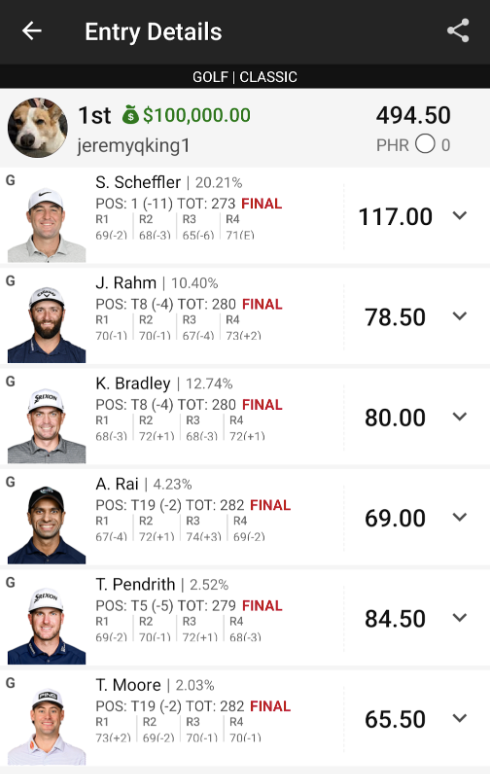Following the approach of Adam Levitan, we’ll leverage the week-long nature of DFS golf every Monday. This will involve scrutinizing what went well and what didn’t from the previous week’s games, independent of the outcomes.
Each week, we’ll analyze a mix of cash-game and GPP lineups, providing insights into our thought process as we prepared for Thursday’s lineup lock and comparing our projection and ownership expectations to the broader field.
Welcome back to another installment of the GPP Lineup Review! As noted by Discord senior lsahr, those who score big over the weekend are naturally expected to contribute more at ETR, so here I am with another article. I’ll go over my $200 Driver single-entry lineup, along with my overall MME strategy for the slate, which significantly influenced how I built both optimized and manually crafted lineups. Please note that I won’t be covering my R4 lineup strategy in this article, but will address that in my upcoming Large-Field GPP Breakdown. Here’s a look at my winning lineup:
Let’s start by discussing my winning lineup and the thought process behind it. As mentioned in last week’s article, I chose to adopt a contrarian strategy, significantly underweighting Rory McIlroy and completely avoiding Keith Mitchell. My aim was to construct unique team compositions, and that was indeed how I formed this lineup. In smaller contests—like The Driver this week with 2,200 entries—I anticipated ownership would cluster around Rory, Bryson, Mitchell, and Mackenzie Hughes, a sentiment echoed by Sam in his notes on small-field ownership. It’s crucial to consider these ownership dynamics when crafting lineups for these contests.
The positive for me was that Sam’s predictions about ownership in smaller fields were accurate. Rory (39%), Bryson (34%), Mitchell (31%), and Hughes (15%) had ownership levels that exceeded their large-field counterparts, especially Mitchell, who surprisingly reached over 30%. Understanding this trend allowed me to leverage the field’s misjudgment by opting for Scottie Scheffler and Jon Rahm, who had favorable projections from the ETR team and were expected to have lower ownership in comparison to larger fields. Securing both Scheffler and Rahm at a combined 30% ownership felt like a strategic advantage.
Reviewing MME Strategies
Despite breaking even in MME this week, it’s important to delve into my overall strategy. I won’t share full exposure details here, as this article focuses on my single-entry lineup. Nonetheless, the principles I discussed in my GPP Breakdown were incorporated into my MME set. For instance, I took an extreme underweight position on Rory and Bryson, reallocating ownership to various other $10K+ players. I also targeted numerous combinations featuring these high-end players. I adjusted my lineups in The SOLVER to achieve this.
With this framework, I developed lineups with a mix of contrarian stars and budget-friendly players, creating 150 combinations that conformed to my ownership targets. This was crucial given the large field size. The key is to differentiate your lineups to compete effectively in GPPs.
Optimizing with Tools
I often emphasize that DFS players often misuse optimizers, viewing them merely as tools for generating lineups. However, they can be leveraged to manipulate ownership and combinations effectively through specific rules. For instance, I created rules in my optimizer for the PGA Championship that aimed to balance ownership between players, enhancing my unique lineup strategies.
Ultimately, DFS is about outmaneuvering your opponents. By strategically differentiating my lineups and utilizing top projections as a foundation, I’ve seen success in PGA DFS. If you have inquiries, feel free to reach out to me on Discord, and I hope you found this article useful in your DFS pursuits.



